A Multi–Step Approach for Optically Active and Inactive Water Quality Parameter Estimation Using Deep Learning and Remote Sensing
Abstract
:1. Introduction
- The extraction of the stream network for the Rawal watershed from the SRTM DEM.
- The extraction of a total of eight water quality parameters, six optically active and two optically inactive water quality parameters, by applying estimated band equations on Landsat 8 satellite imagery for the Rawal watershed stream network pertaining to the years 2014–2021.
- The application of deep learning models for current and future multi–step forecasting of an optically active parameter, i.e., EC, and an optically inactive parameter, i.e., DO, using optically active/inactive water quality parameters. The analysis conducted using the deep learning models demonstrated the decline in water quality over the eight–year period and revealed that the factors that have contributed to the deterioration in water quality include seasonal variations and other environmental variables.
2. Materials and Methods
2.1. Study Area
2.2. Data Acquisition
Water Quality Parameter Extraction from Landsat Images
- Conversion of Digital Numbers (DN) to Top–Of–Atmosphere (TOA) Reflectance:Preprocessing of the satellite images comprised operations including atmospheric or geometric correction and normalization. The first step of retrieving the water quality features involved the conversion of the DNs or the pixels in the satellite image to TOA reflectance values. TOA reflectance values include factors from clouds, atmospheric aerosols and gases. These DNs are converted to ToA reflectance values using rescaling coefficients and parameters found in the metadata file provided with the data and using the following expression:In Equation (1), = TOA reflectance for band number x; = REFLECTANCE_MULT_BAND_x, = standard pixels of band x or DN of band x; and = REFLECTANCE_ADD_BAND_x where x is band 2, 3, 4, 5 and 6, respectively. This conversion formula uses values such as REFLECTANCE_MULT_BAND and REFLECTANCE_ADD_BAND, which are kept in the metadata set with each image. REFLECTANCE_MULT_BAND is multiplied for the reflectance correction valueto be applied with each input band and its default value for Landsat 8 is 0.00002. Similarly, the REFLECTANCE_ADD_BAND is the addictive correction value for reflectance to be applied with each input band and its default value is −0.1 [46].
- Application of the Estimated Equations:The optically active/inactive features were then calculated by applying the algorithms given in Table 2. These methods were selected as they performed the best amongst others for the selected study area. Band math analysis was applied to the images using the Google Earth Engine. A total of 0.82 M sample points for every feature were extracted.Each feature was calculated based on different band combinations. The optically inactive pH feature used a combination of bands 3, 4 and 6. The optically active turbidity feature was extracted with bands 3, 4 and 5. Bands 1 and 5 were used to extract EC and TDS. A combination of bands 2 and 4 were used to extract DO and SDD. Finally, bands 2, 3, 4 and 5 were used to retrieve chl–.
- Evaluation of the Equation:The methods were evaluated by comparing them with the observed ground parameters for the study area. The best–performing method on the selected study area was selected for extracting the sample points.
2.3. Deep Learning Models
2.3.1. Multi–Layer Perceptron (MLP)
2.3.2. Convolutional Neural Network (CNN)
2.3.3. Fully Connected Network (FCN)
2.3.4. Recurrent Neural Network (RNN)
2.3.5. Long Short Term Memory (LSTM) and Its Variants
2.3.6. Training of the Deep Learning Model
- Data Preparation: The dataset was converted into a time series dataset by transforming the timestamp column as an index.
- Normalization: All features in the dataset were normalized in the range of 0 to 1, in a process referred to as min–max normalization. For every water quality feature, the values were in different units. For example, the pH of water was mostly in the range of 6 to 9. Similarly, the EC of water lay in the range of 400 µS/cm to 1000 µS/cm. Thus, to bring uniformity into the dataset, the values were normalized for each feature in the range of 0 to 1.
- Series to Supervised: The dataset was then further transformed for a supervised learning problem by splitting the input sequence, i.e., the input data at the current time (t) were split into a three dimensional shape (samples, time steps, features) for a multiple input multi–step time series, where a lag time (t − n) and further time steps (t + 1, t + 2, …, t + n) were defined for features (n).
- Training and test sets: The transformed dataset was then split into training and test sets. Here, the last 2 years’ worth of data (220,845 samples) were selected as the test set and 5 years’ worth of data (600,000 samples) were selected as the training set.
- Model Parameters: The parameters (neurons, epochs, and hidden layers) of the deep model were initialized. Here, each deep model had a different set of parameters with a difference in dropout layers and hidden layers.
- Model Evaluation: The model was evaluated based on the three loss functions, i.e., root mean square error (RMSE), mean absolute error (MAE), and mean absolute percentage error (MAPE). RMSE and MAE give the error in the same units as the predicted variable and MAPE is given as a percentage (%).
3. Results and Discussion
- Predict the DO and EC at the current time event (t) given the eight water quality features at the prior time steps, that is, a lag time period of three (t − 3, t − 2, t − 1).
- Predict the DO and EC for the next three events (t + 1, t + 2, t + 3) based on the eight water quality features at the prior time steps with a lag time period of one (t − 1).
4. Conclusions
Author Contributions
Funding
Institutional Review Board Statement
Informed Consent Statement
Data Availability Statement
Conflicts of Interest
Abbreviations
| Recurrent Neural Network | RNN |
| Shuttle Radar Topography Mission | SRTM |
| Digital Elevation Model | DEM |
| Total Dissolved Solids | TDS |
| Electric Conductivity | EC |
| Chlorophyll– | Chl- |
| Secchi Disk Depth | SDD |
| Land Surface Temperature | LST |
| Dissolved Oxygen | DO |
| Collection 1 Level 1 | C1 L1 |
| United States Geological Survey | USGS |
| Digital Numbers | DN |
| Top Of Atmosphere | TOA |
| Long Short Term Memory | LSTM |
| Vanilla LSTM | V–LSTM |
| Stacked LSTM | S–LSTM |
| Bidirectional LSTM | Bi–LSTM |
| Convolutional LSTM | Conv–LSTM |
| Root Mean Square Error | RMSE |
| Mean Absolute Error | MAE |
| Mean Absolute Percentage Error | MAPE |
| Convolutional Neural Network | CNN |
| Fully Connected Network | FCN |
| Multi–Layer Perceptron | MLP |
References
- Hamzaoui-Azaza, F.; Ketata, M.; Bouhlila, R.; Gueddari, M.; Riberio, L. Hydrogeochemical characteristics and assessment of drinking water quality in Zeuss–Koutine aquifer, southeastern Tunisia. Environ. Monit. Assess. 2011, 174, 283–298. [Google Scholar] [CrossRef] [PubMed]
- Pazand, K.; Hezarkhani, A.; Ghanbari, Y.; Aghavali, N. Groundwater geochemistry in the Meshkinshahr basin of Ardabil province in Iran. Environ. Earth Sci. 2012, 65, 871–879. [Google Scholar] [CrossRef]
- Issaka, S.; Ashraf, M.A. Impact of soil erosion and degradation on water quality: A review. Geol. Ecol. Landscapes 2017, 1, 1–11. [Google Scholar] [CrossRef] [Green Version]
- Qadir, A.; Malik, R.N.; Husain, S.Z. Spatio-temporal variations in water quality of Nullah Aik-tributary of the river Chenab, Pakistan. Environ. Monit. Assess. 2008, 140, 43–59. [Google Scholar] [CrossRef]
- Nazeer, S.; Hashmi, M.Z.; Malik, R.N. Heavy metals distribution, risk assessment and water quality characterization by water quality index of the River Soan, Pakistan. Ecol. Indic. 2014, 43, 262–270. [Google Scholar] [CrossRef]
- Bhatti, N.; Siyal, A.; Qureshi, A. Groundwater quality assessment using water quality index: A Case study of Nagarparkar, Sindh, Pakistan. Sindh Univ. Res.-J.-Surj. (Sci. Ser.) 2018, 50, 227–234. [Google Scholar]
- Chen, L.; Tan, C.H.; Kao, S.J.; Wang, T.S. Improvement of remote monitoring on water quality in a subtropical reservoir by incorporating grammatical evolution with parallel genetic algorithms into satellite imagery. Water Res. 2008, 42, 296–306. [Google Scholar] [CrossRef]
- Hsu, H.H.; Chen, L.; Kou, C.H.; Yeh, H.C.; Wang, T.S. Applying Multi-temporal Satellite Imageries to Estimate Chlorophyll-a Concentration in Feitsui Reservoir Using ANNs. In Proceedings of the 2009 International Joint Conference on Artificial Intelligence, Hainan, China, 25–26 April 2009; IEEE Computer Society: Los Alamitos, CA, USA, 2009; pp. 345–348. [Google Scholar]
- Wen, X.P.; Yang, X.F. Monitoring of water quality using remote sensing techniques. Appl. Mech. Mater. 2010, 29, 2360–2364. [Google Scholar] [CrossRef]
- Fichot, C.G.; Downing, B.D.; Bergamaschi, B.A.; Windham-Myers, L.; Marvin-DiPasquale, M.; Thompson, D.R.; Gierach, M.M. High-resolution remote sensing of water quality in the San Francisco Bay–Delta Estuary. Environ. Sci. Technol. 2016, 50, 573–583. [Google Scholar] [CrossRef]
- Ritchie, J.C.; Zimba, P.V.; Everitt, J.H. Remote sensing techniques to assess water quality. Photogramm. Eng. Remote Sens. 2003, 69, 695–704. [Google Scholar] [CrossRef] [Green Version]
- Kallio, K. Remote sensing as a tool for monitoring lake water quality. Hydrol. Limnol. Asp. Lake Monit. 2000, 14, 237. [Google Scholar]
- Ahmed, M.; Mumtaz, R.; Baig, S.; Zaidi, S.M.H. Assessment of correlation amongst physico-chemical, topographical, geological, lithological and soil type parameters for measuring water quality of Rawal watershed using remote sensing. Water Supply 2022, 22, 3645–3660. [Google Scholar] [CrossRef]
- Ahmed, M.; Mumtaz, R.; Hassan Zaidi, S.M. Analysis of water quality indices and machine learning techniques for rating water pollution: A case study of Rawal Dam, Pakistan. Water Supply 2021, 21, 3225–3250. [Google Scholar] [CrossRef]
- Xiang, L.; Li, J.; Hu, A.; Zhang, Y. Deterministic and probabilistic multi-step forecasting for short-term wind speed based on secondary decomposition and a deep learning method. Energy Convers. Manag. 2020, 220, 113098. [Google Scholar] [CrossRef]
- Yan, K.; Wang, X.; Du, Y.; Jin, N.; Huang, H.; Zhou, H. Multi-step short-term power consumption forecasting with a hybrid deep learning strategy. Energies 2018, 11, 3089. [Google Scholar] [CrossRef] [Green Version]
- Jayasinghe, W.L.P.; Deo, R.C.; Ghahramani, A.; Ghimire, S.; Raj, N. Deep Multi-Stage Reference Evapotranspiration Forecasting Model: Multivariate Empirical Mode Decomposition Integrated With the Boruta-Random Forest Algorithm. IEEE Access 2021, 9, 166695–166708. [Google Scholar] [CrossRef]
- Lv, Z.; Xu, J.; Zheng, K.; Yin, H.; Zhao, P.; Zhou, X. Lc-rnn: A deep learning model for traffic speed prediction. In Proceedings of the 27th International Joint Conference on Artificial Intelligence (IJCAI-18), Stockholm, Sweden, 13–19 July 2018; Volume 2018, p. 27. [Google Scholar]
- Bloemheuvel, S.; Hoogen, J.v.d.; Jozinović, D.; Michelini, A.; Atzmueller, M. Multivariate Time Series Regression with Graph Neural Networks. arXiv 2022, arXiv:2201.00818. [Google Scholar]
- Dumas, J.; Cointe, C.; Fettweis, X.; Cornélusse, B. Deep learning-based multi-output quantile forecasting of PV generation. In Proceedings of the 2021 IEEE Madrid PowerTech, Madrid, Spain, 28 June–2 July 2021; IEEE: Piscataway, NJ, USA, 2021; pp. 1–6. [Google Scholar]
- Gitelson, A.A.; Merzlyak, M.N. Remote sensing of chlorophyll concentration in higher plant leaves. Adv. Space Res. 1998, 22, 689–692. [Google Scholar] [CrossRef]
- Xu, M.; Liu, H.; Beck, R.; Lekki, J.; Yang, B.; Shu, S.; Liu, Y.; Benko, T.; Anderson, R.; Tokars, R.; et al. Regionally and locally adaptive models for retrieving chlorophyll-a concentration in inland waters from remotely sensed multispectral and hyperspectral imagery. IEEE Trans. Geosci. Remote Sens. 2019, 57, 4758–4774. [Google Scholar] [CrossRef]
- Harrington, J.A., Jr.; Schiebe, F.R.; Nix, J.F. Remote sensing of Lake Chicot, Arkansas: Monitoring suspended sediments, turbidity, and Secchi depth with Landsat MSS data. Remote Sens. Environ. 1992, 39, 15–27. [Google Scholar] [CrossRef]
- Imen, S.; Chang, N.B.; Yang, Y.J. Developing the remote sensing-based early warning system for monitoring TSS concentrations in Lake Mead. J. Environ. Manag. 2015, 160, 73–89. [Google Scholar] [CrossRef]
- Sharaf El Din, E. A novel approach for surface water quality modelling based on Landsat-8 tasselled cap transformation. Int. J. Remote Sens. 2020, 41, 7186–7201. [Google Scholar] [CrossRef]
- Lim, J.; Choi, M. Assessment of water quality based on Landsat 8 operational land imager associated with human activities in Korea. Environ. Monit. Assess. 2015, 187, 1–17. [Google Scholar] [CrossRef] [PubMed]
- Kapalanga, T.S. Assessment and Development of Remote Sensing Based Algorithms for Water Quality Monitoring in Olushandja Dam, North-Central Namibia. Master’s Thesis, University of Zimbabwe, Harare, Zimbabwe, 2015. [Google Scholar]
- Liu, H.; Xu, M.; Beck, R. An Ensemble Approach to Retrieving Water Quality Parameters from Multispectral Satellite Imagery. In Proceedings of the IGARSS 2018-2018 IEEE International Geoscience and Remote Sensing Symposium, Valencia, Spain, 22–27 July 2018; IEEE: Piscataway, NJ, USA, 2018; pp. 9284–9287. [Google Scholar]
- Wang, J.; Shi, T.; Yu, D.; Teng, D.; Ge, X.; Zhang, Z.; Yang, X.; Wang, H.; Wu, G. Ensemble machine-learning-based framework for estimating total nitrogen concentration in water using drone-borne hyperspectral imagery of emergent plants: A case study in an arid oasis, NW China. Environ. Pollut. 2020, 266, 115412. [Google Scholar] [CrossRef] [PubMed]
- El Din, E.S.; Zhang, Y. Estimation of both optical and nonoptical surface water quality parameters using Landsat 8 OLI imagery and statistical techniques. J. Appl. Remote Sens. 2017, 11, 046008. [Google Scholar]
- Theologou, I.; Patelaki, M.; Karantzalos, K. Can single empirical algorithms accurately predict inland shallow water quality status from high resolution, multi-sensor, multi-temporal satellite data? Int. Arch. Photogramm. Remote Sens. Spat. Inf. Sci. 2015, 40, 1511. [Google Scholar] [CrossRef] [Green Version]
- Tan, G.; Yan, J.; Gao, C.; Yang, S. Prediction of water quality time series data based on least squares support vector machine. Procedia Eng. 2012, 31, 1194–1199. [Google Scholar] [CrossRef] [Green Version]
- Najafzadeh, M.; Homaei, F.; Farhadi, H. Reliability assessment of water quality index based on guidelines of national sanitation foundation in natural streams: Integration of remote sensing and data-driven models. Artif. Intell. Rev. 2021, 54, 4619–4651. [Google Scholar] [CrossRef]
- Vakili, T.; Amanollahi, J. Determination of optically inactive water quality variables using Landsat 8 data: A case study in Geshlagh reservoir affected by agricultural land use. J. Clean. Prod. 2020, 247, 119134. [Google Scholar] [CrossRef]
- Najafzadeh, M.; Ghaemi, A.; Emamgholizadeh, S. Prediction of water quality parameters using evolutionary computing-based formulations. Int. J. Environ. Sci. Technol. 2019, 16, 6377–6396. [Google Scholar] [CrossRef]
- Miikkulainen, R.; Liang, J.; Meyerson, E.; Rawal, A.; Fink, D.; Francon, O.; Raju, B.; Shahrzad, H.; Navruzyan, A.; Duffy, N.; et al. Evolving deep neural networks. In Artificial Intelligence in the Age of Neural Networks and Brain Computing; Elsevier: Cambridge, MA, USA, 2019; pp. 293–312. [Google Scholar]
- Pyo, J.C.; Ligaray, M.; Kwon, Y.S.; Ahn, M.H.; Kim, K.; Lee, H.; Kang, T.; Cho, S.B.; Park, Y.; Cho, K.H. High-spatial resolution monitoring of phycocyanin and chlorophyll-a using airborne hyperspectral imagery. Remote Sens. 2018, 10, 1180. [Google Scholar] [CrossRef] [Green Version]
- Niu, C.; Tan, K.; Jia, X.; Wang, X. Deep learning based regression for optically inactive inland water quality parameter estimation using airborne hyperspectral imagery. Environ. Pollut. 2021, 286, 117534. [Google Scholar] [CrossRef] [PubMed]
- Faruk, D.Ö. A hybrid neural network and ARIMA model for water quality time series prediction. Eng. Appl. Artif. Intell. 2010, 23, 586–594. [Google Scholar] [CrossRef]
- Zhang, L.; Ma, X.; Shi, P.; Bi, S.; Wang, C. Regcnn: A deep multi-output regression method for wastewater treatment. In Proceedings of the 2019 IEEE 31st International Conference on Tools with Artificial Intelligence (ICTAI), Portland, OR, USA, 4–6 November 2019; IEEE: Piscataway, NJ, USA, 2019; pp. 816–823. [Google Scholar]
- Yu, Y.; Si, X.; Hu, C.; Zhang, J. A review of recurrent neural networks: LSTM cells and network architectures. Neural Comput. 2019, 31, 1235–1270. [Google Scholar] [CrossRef] [PubMed]
- Ashraf, A. Chapter: Changing Hydrology of the Himalayan Watershed. 2013. Available online: https://www.intechopen.com/chapters/43184 (accessed on 13 May 2022).
- ArcGIS Pro. Available online: https://www.esri.com/en-us/arcgis/products/arcgis-pro/overview (accessed on 13 May 2022).
- Survey, U.U.G. Earthexplorer. Available online: https://earthexplorer.usgs.gov/ (accessed on 13 May 2022).
- Gorde, S.; Jadhav, M. Assessment of water quality parameters: A review. J. Eng. Res. Appl. 2013, 3, 2029–2035. [Google Scholar]
- Paul, B. Estimation of Greenfield Changes in Kerala using NDVI on Landsat Data. Pramana Res. J. 2019, 9, 757–770. [Google Scholar]
- Abdullah, H.S. Water Quality Assessment for Dokan Lake Using Landsat 8 Oli Satellite Images. Master’s Thesis, University of Sulaimani, Sulaymaniyah, Iraq, 2015. [Google Scholar]
- Khattab, M.F.; Merkel, B.J. Application of Landsat 5 and Landsat 7 images data for water quality mapping in Mosul Dam Lake, Northern Iraq. Arab. J. Geosci. 2014, 7, 3557–3573. [Google Scholar] [CrossRef]
- Khalil, M.T.; Saad, A.; Ahmed, M.; El Kafrawy, S.B.; Emam, W.W. Integrated field study, remote sensing and GIS approach for assessing and monitoring some chemical water quality parameters in Bardawil lagoon, Egypt. Int. J. Innov. Res. Sci. Eng. Technol. 2016, 5, 10–15680. [Google Scholar]
- Deutsch, E.; Alameddine, I.; El-Fadel, M. Developing Landsat Based Algorithms to Augment in Situ Monitoring of Freshwater Lakes and Reservoirs. In Proceedings of the 11th International Conference on Hydroinformatics, New York, NY, USA, 17–21 August 2014; City University of New York (CUNY): New York, NY, USA, 2014; Volume 1. [Google Scholar]
- Avdan, U.; Jovanovska, G. Algorithm for automated mapping of land surface temperature using LANDSAT 8 satellite data. J. Sens. 2016, 2016, 1480307. [Google Scholar] [CrossRef] [Green Version]
- Srivastava, N.; Hinton, G.; Krizhevsky, A.; Sutskever, I.; Salakhutdinov, R. Dropout: A simple way to prevent neural networks from overfitting. J. Mach. Learn. Res. 2014, 15, 1929–1958. [Google Scholar]
- Szegedy, C.; Liu, W.; Jia, Y.; Sermanet, P.; Reed, S.; Anguelov, D.; Erhan, D.; Vanhoucke, V.; Rabinovich, A. Going deeper with convolutions. In Proceedings of the IEEE Conference on Computer Vision and Pattern Recognition, Boston, MA, USA, 7–12 June 2015; pp. 1–9. [Google Scholar]
- Krizhevsky, A.; Sutskever, I.; Hinton, G.E. Imagenet classification with deep convolutional neural networks. Adv. Neural Inf. Process. Syst. 2012, 25. [Google Scholar] [CrossRef]
- Zhao, B.; Lu, H.; Chen, S.; Liu, J.; Wu, D. Convolutional neural networks for time series classification. J. Syst. Eng. Electron. 2017, 28, 162–169. [Google Scholar] [CrossRef]
- Wang, Z.; Yan, W.; Oates, T. Time series classification from scratch with deep neural networks: A strong baseline. In Proceedings of the 2017 International Joint Conference on Neural Networks (IJCNN), Anchorage, AK, USA, 14–19 May 2017; IEEE: Piscataway, NJ, USA, 2017; pp. 1578–1585. [Google Scholar]
- Medsker, L.R.; Jain, L. Recurrent neural networks. Des. Appl. 2001, 5, 64–67. [Google Scholar]
- Hochreiter, S.; Schmidhuber, J. Long short-term memory. Neural Comput. 1997, 9, 1735–1780. [Google Scholar] [CrossRef]
- Graves, A.; Jaitly, N.; Mohamed, A.r. Hybrid speech recognition with deep bidirectional LSTM. In Proceedings of the 2013 IEEE Workshop on Automatic Speech Recognition and Understanding, Olomouc, Czech Republic, 8–12 December 2013; IEEE: Piscataway, NJ, USA, 2013; pp. 273–278. [Google Scholar]
- Boden, M. A guide to recurrent neural networks and backpropagation. Dallas Proj. 2002, 2, 1–10. [Google Scholar]
- Sallam, G.A.; Elsayed, E. Estimating the impact of air temperature and relative humidity change on the water quality of Lake Manzala, Egypt. J. Nat. Resour. Dev. 2015, 5, 76–87. [Google Scholar] [CrossRef] [Green Version]
- Gray, N.F. Drinking Water Quality: Problems and Solutions, 2nd ed.; Cambridge University Press: Cambridge, UK, 2008. [Google Scholar]
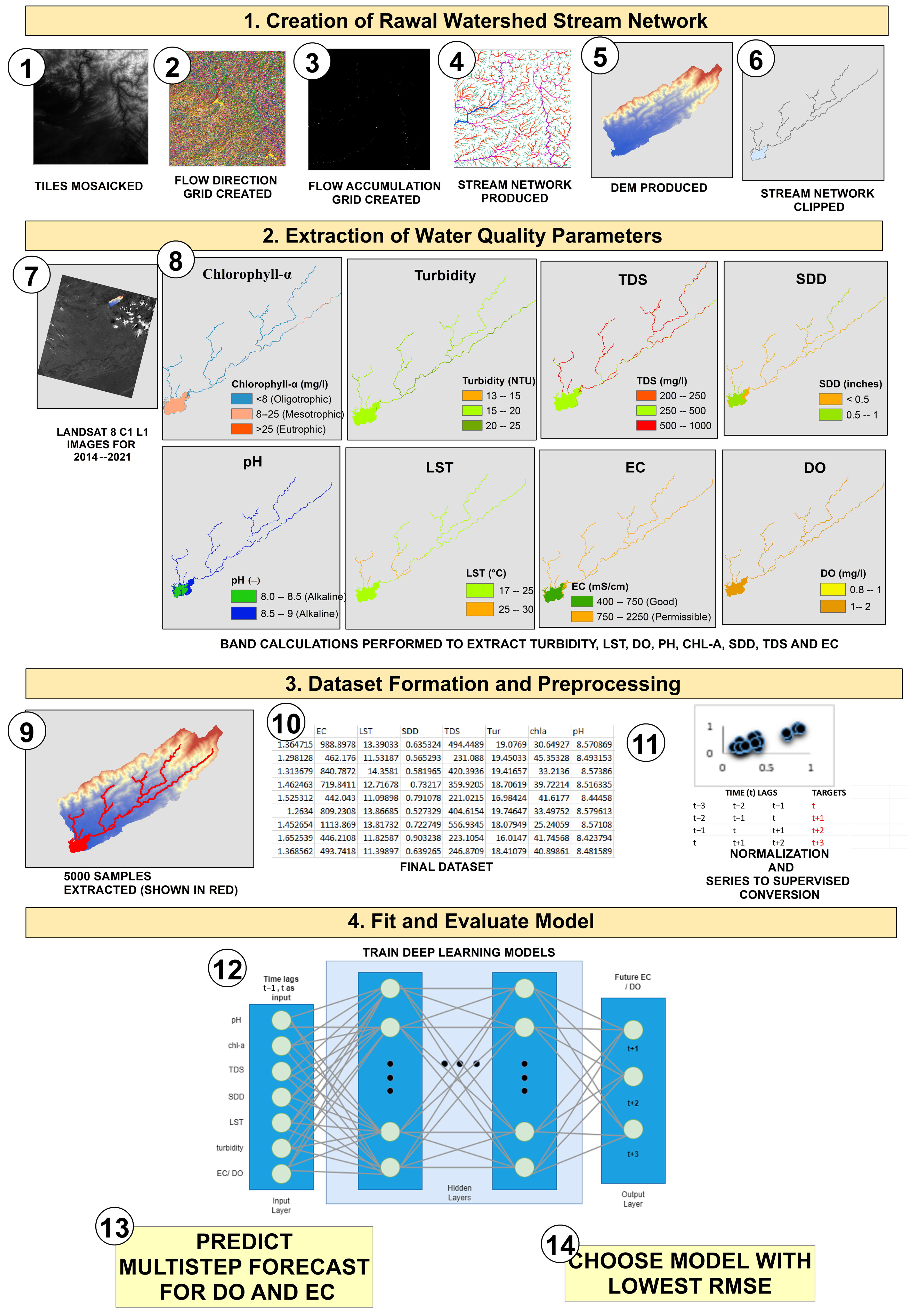
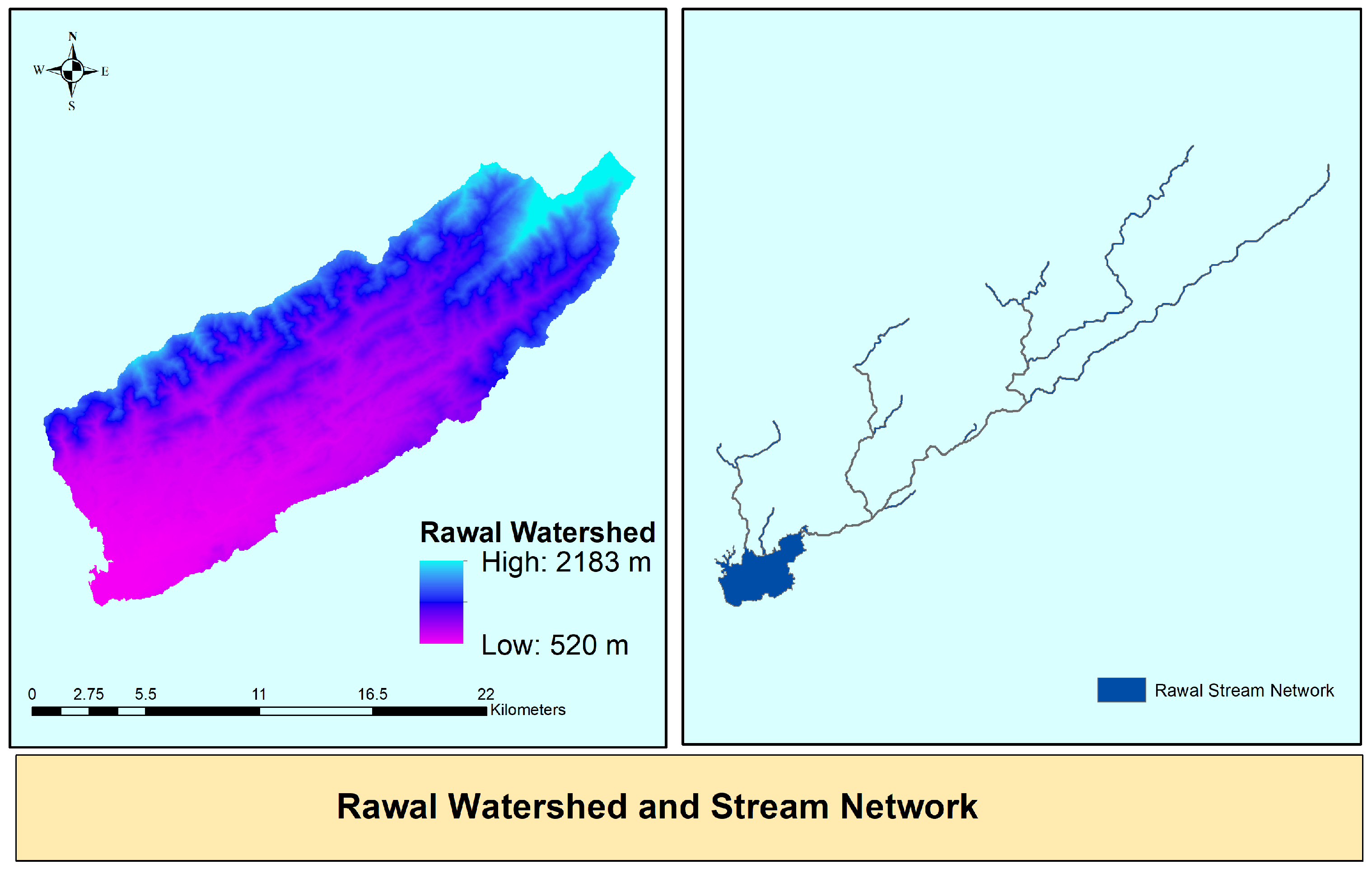

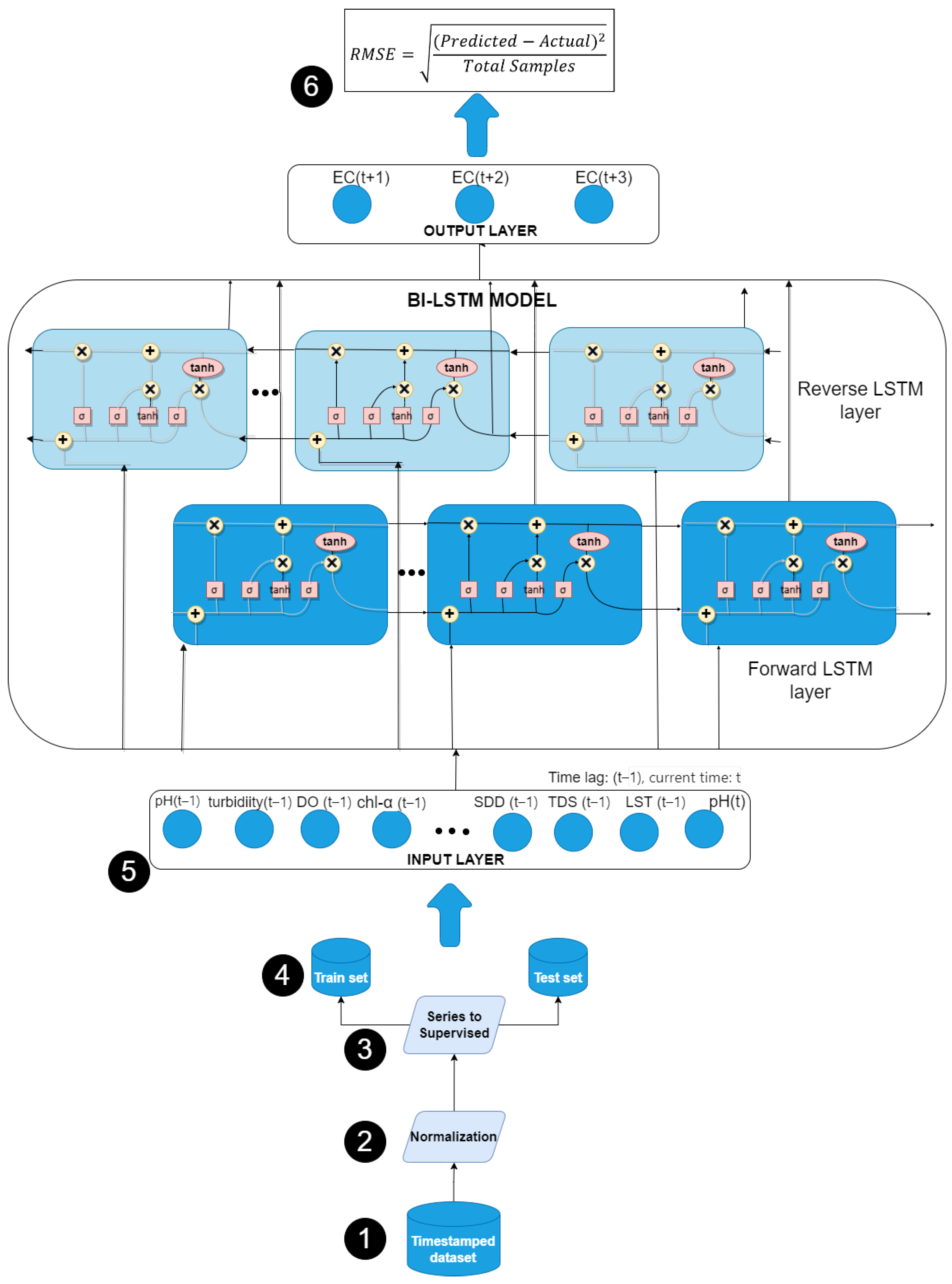
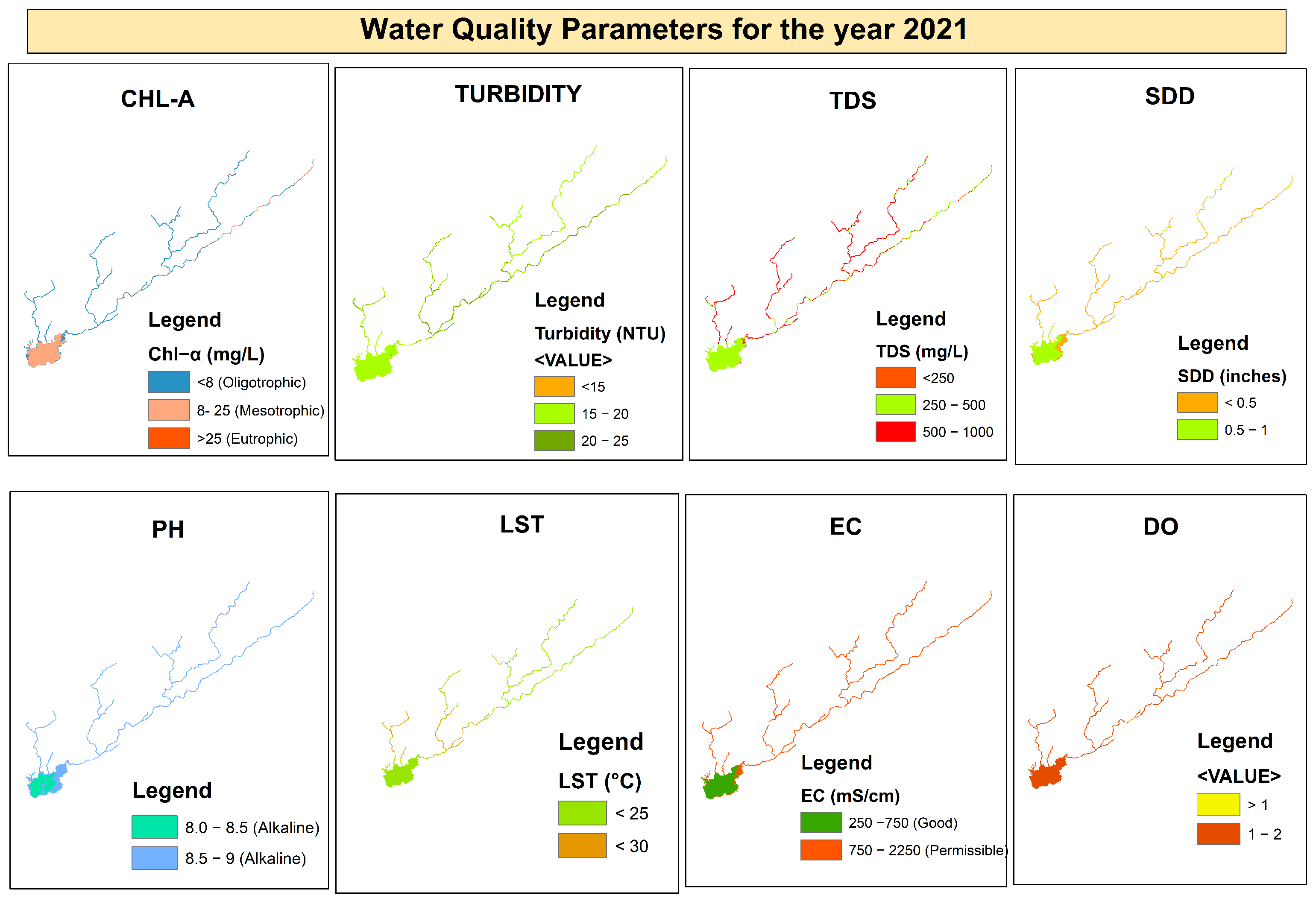
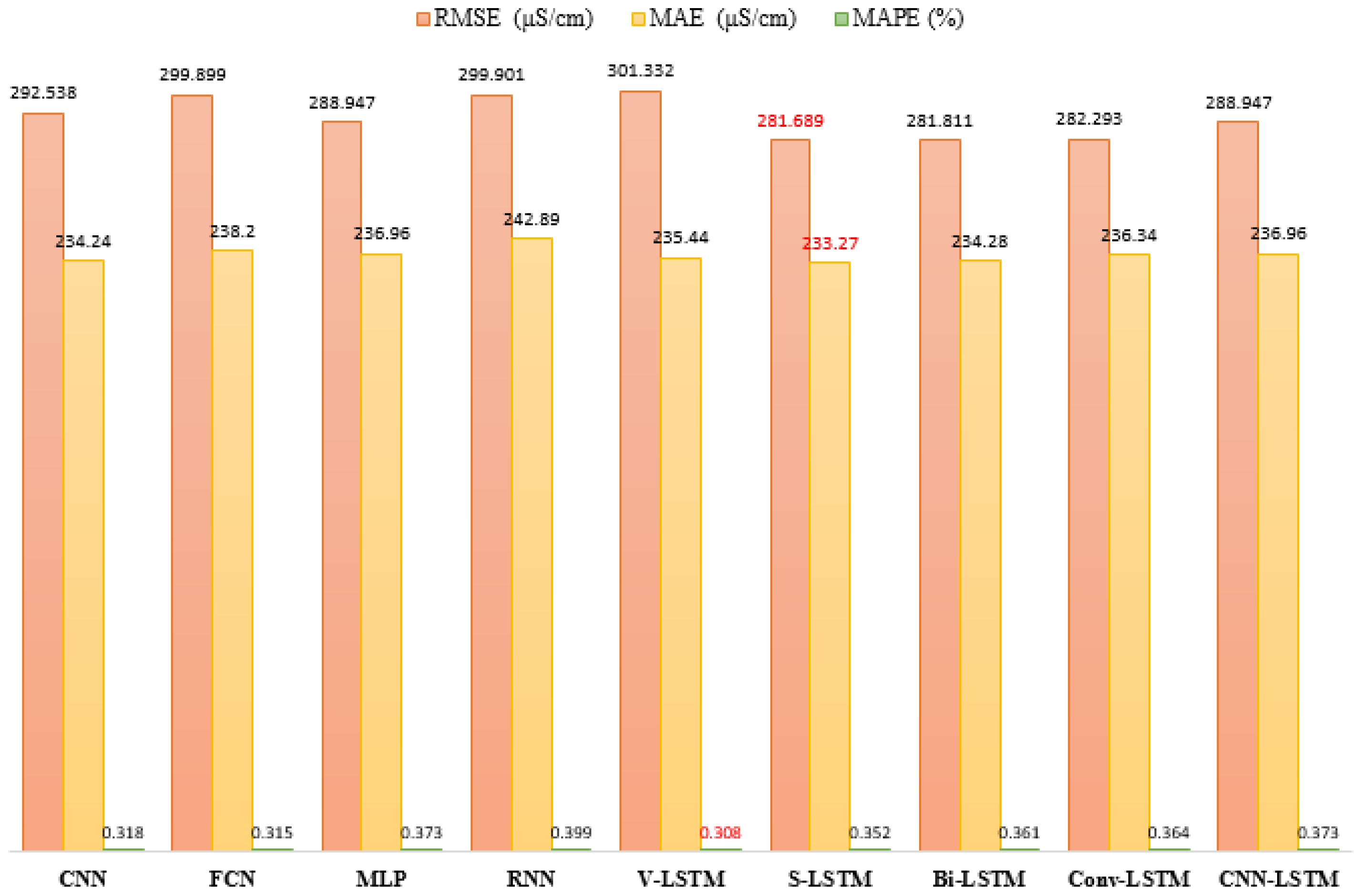
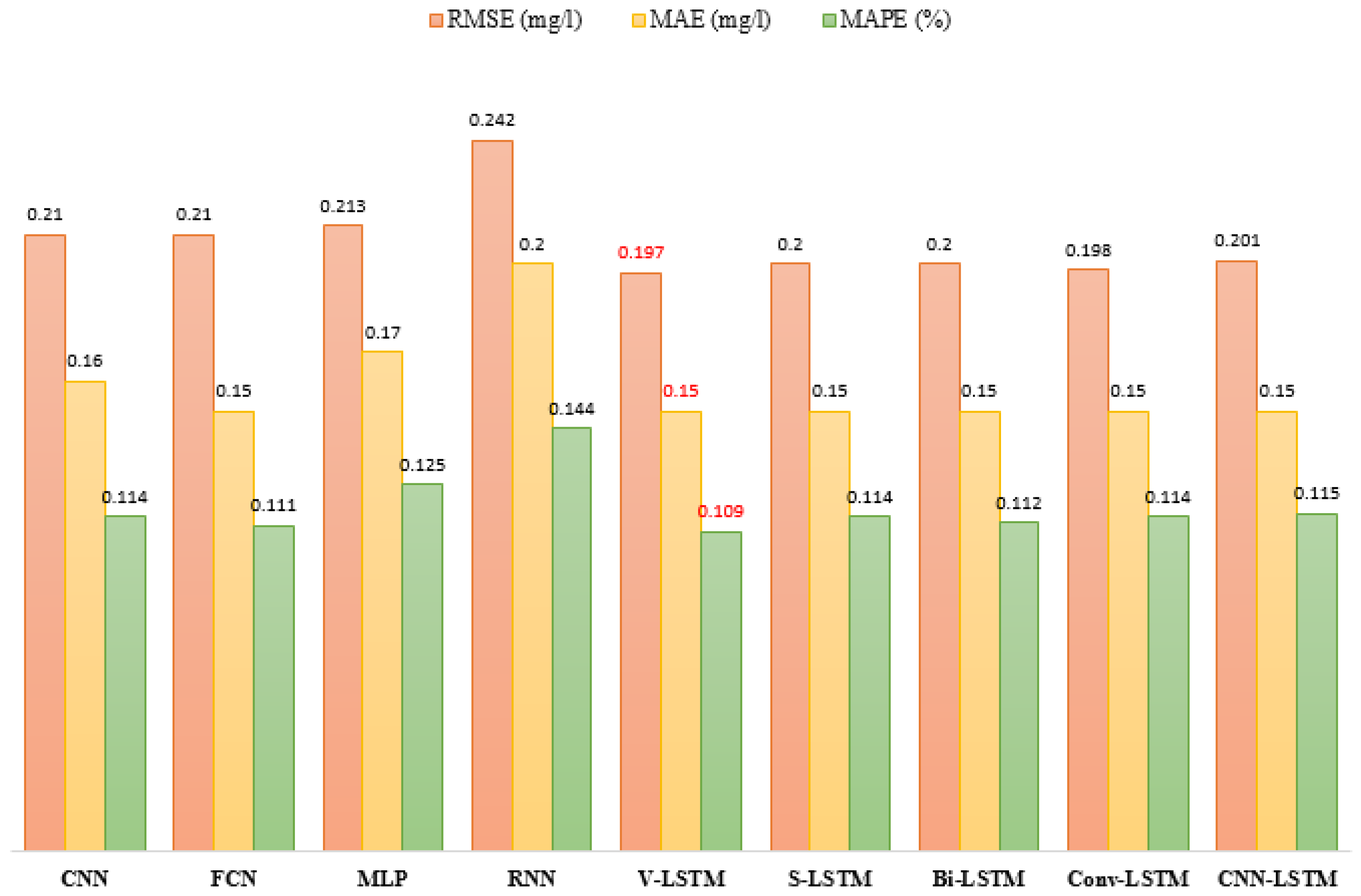
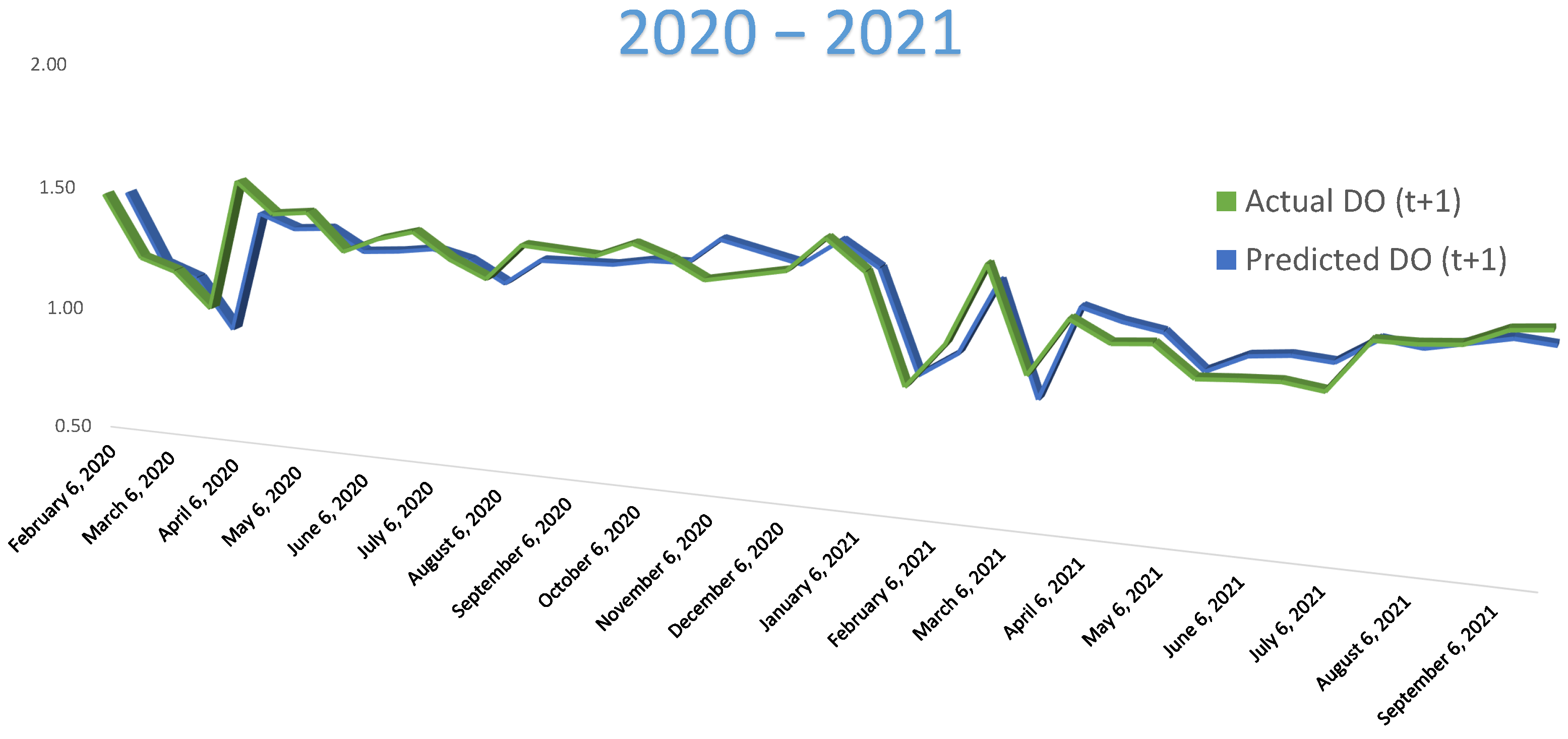
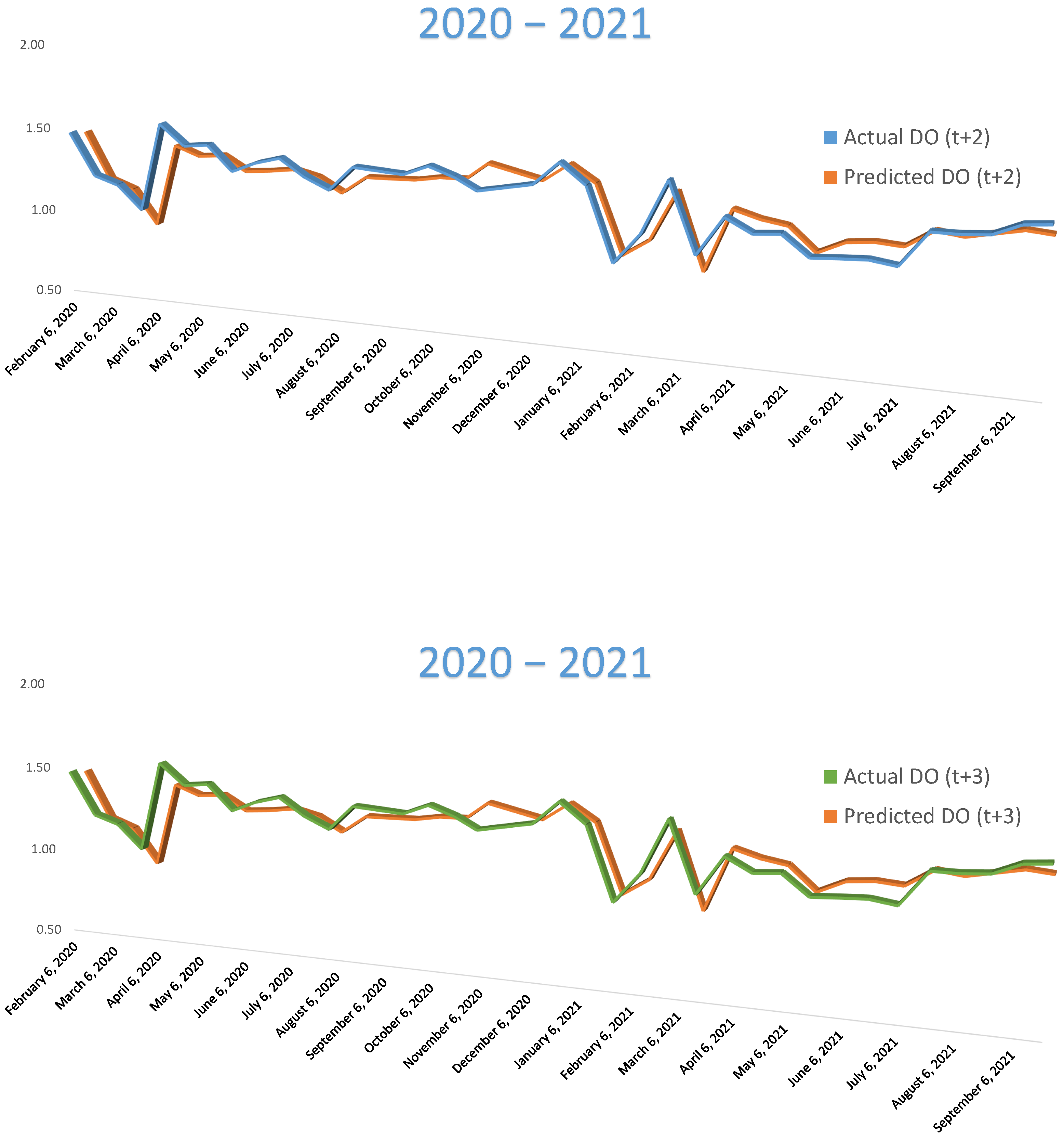
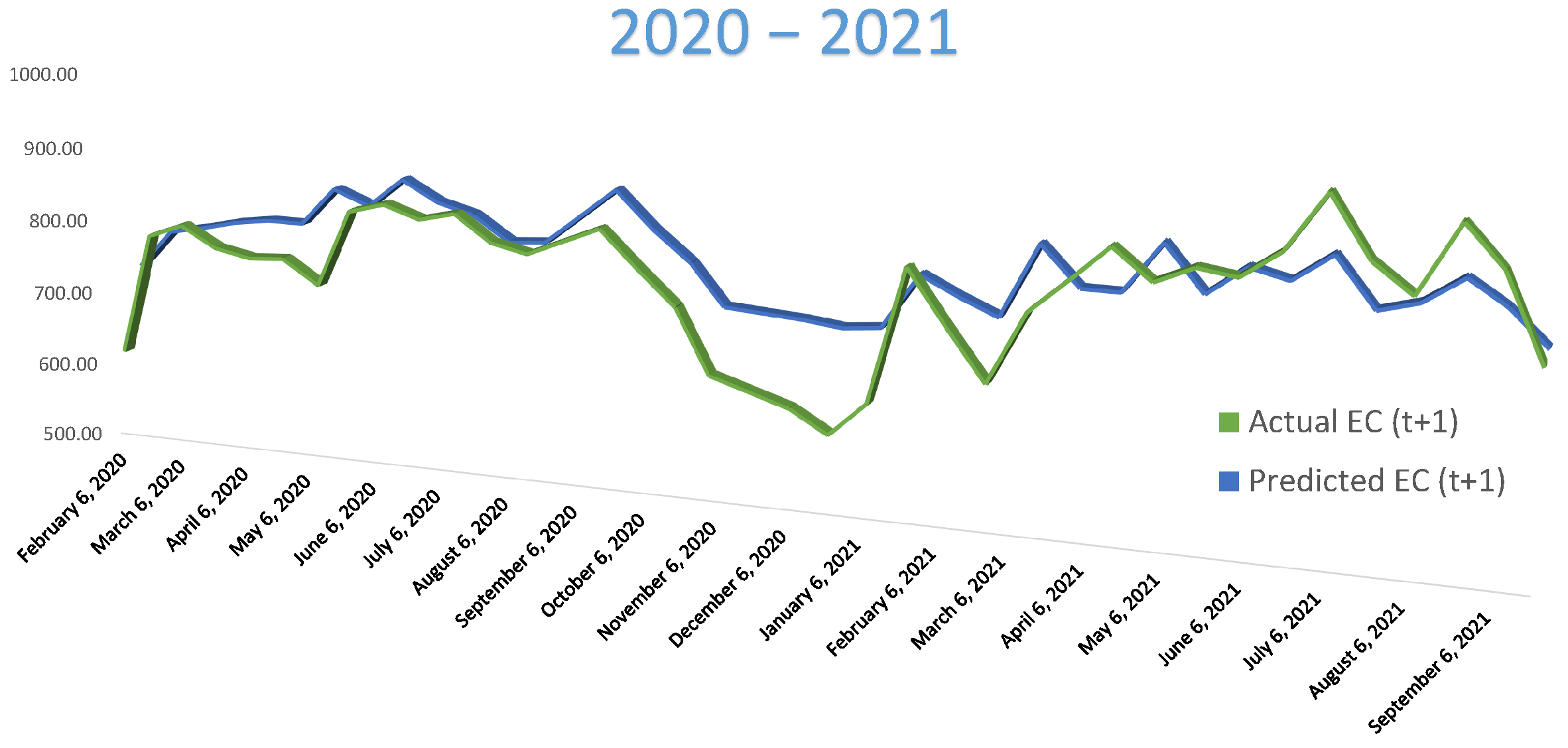
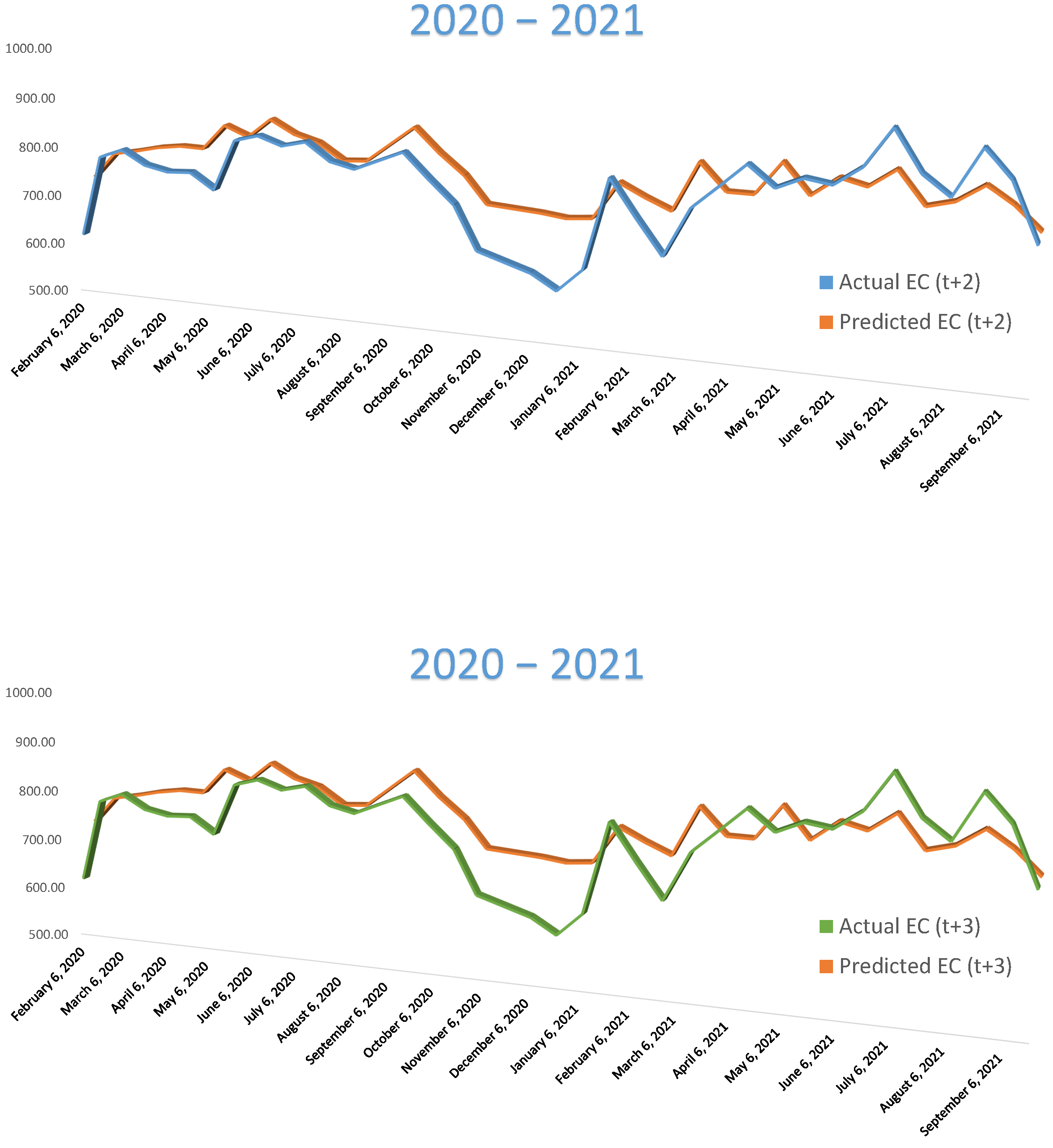
| Years | No. of Images | Preprocessed Images that Cover Rawal Lake | No. of Samples |
|---|---|---|---|
| 2014 | 41 | 22 | 107,492 |
| 2015 | 42 | 21 | 102,606 |
| 2016 | 44 | 23 | 112,378 |
| 2017 | 45 | 23 | 112,378 |
| 2018 | 42 | 21 | 102,606 |
| 2019 | 43 | 22 | 107,492 |
| 2020 | 38 | 19 | 92,834 |
| 2021 | 32 | 16 | 83,062 |
| Total | 327 | 167 | 820,848 |
| Parameters | Adapted Equation | Equation No | Reference |
|---|---|---|---|
| pH | + ( × ) − ( × (()/())) | 2 | [47] |
| Turbidity | − ( × (/)) − ( × ) | 3 | [48] |
| DO | () / () | 4 | [31,49] |
| TDS | + × (/) | 5 | [47] |
| EC | + × (/) | 6 | [47] |
| chl– | + × − × + × − × | 7 | [26] |
| SDD | + × ln(/) | 8 | [50] |
| LST | = × + 1 | 9 | [51] |
| = /ln (1 + /) 2 | 10 | ||
| NDVI = (NIR − VIS)/(NIR + VIS) 3 | 11 | ||
| = ((NDVI − )/( − )) | 12 | ||
| = × + | 13 | ||
| LST = BT/ (1 + ( × BT/) × (ln ())) − 4 | 14 |
| DO | EC | LST | SDD | TDS | Tur | chl– | pH |
|---|---|---|---|---|---|---|---|
| 1.69 | 487.22 | 23.71 | 0.94 | 243.61 | 15.51 | 31.23 | 8.43 |
| 1.69 | 466.66 | 23.14 | 0.94 | 233.33 | 15.73 | 32.73 | 8.43 |
| 1.58 | 524.88 | 23.78 | 0.84 | 262.44 | 15.76 | 24.90 | 8.44 |
| 1.37 | 698.71 | 23.78 | 0.64 | 349.36 | 18.71 | 26.96 | 8.53 |
| 1.41 | 713.33 | 24.06 | 0.68 | 356.66 | 17.18 | 14.78 | 8.52 |
| 1.52 | 492.27 | 23.50 | 0.79 | 246.14 | 16.45 | 28.01 | 8.45 |
| 1.54 | 488.48 | 23.43 | 0.80 | 244.24 | 16.14 | 26.70 | 8.44 |
| 1.35 | 824.81 | 22.26 | 0.62 | 412.41 | 18.32 | 13.58 | 8.56 |
| 1.52 | 496.10 | 23.49 | 0.78 | 248.05 | 16.35 | 26.80 | 8.45 |
| 1.47 | 1065.93 | 23.72 | 0.74 | 532.96 | 17.32 | 1.79 | 8.57 |
| 1.66 | 460.37 | 23.40 | 0.91 | 230.19 | 15.63 | 31.76 | 8.43 |
| 1.60 | 526.96 | 23.23 | 0.86 | 263.48 | 16.27 | 28.01 | 8.45 |
| 1.64 | 493.14 | 23.08 | 0.90 | 246.57 | 16.27 | 31.84 | 8.45 |
| 1.25 | 1105.11 | 23.61 | 0.51 | 552.56 | 18.69 | −9.95 | 8.69 |
| 1.69 | 468.18 | 23.62 | 0.93 | 234.09 | 15.72 | 33.26 | 8.43 |
| 1.28 | 685.49 | 18.29 | 0.54 | 342.75 | 19.07 | 1.93 | 8.59 |
| 1.49 | 773.22 | 24.09 | 0.76 | 386.61 | 17.18 | 16.71 | 8.51 |
| 1.50 | 993.48 | 22.87 | 0.77 | 496.74 | 16.65 | 0.72 | 8.53 |
| 1.76 | 456.41 | 23.55 | 0.99 | 228.20 | 15.46 | 35.63 | 8.42 |
| Deep Learner | Lag Time Period | Time Steps | Epochs | Hyperparameters | RMSE (mg/L) | MAE (mg/L) | MAPE (%) |
|---|---|---|---|---|---|---|---|
| CNN | 1 | 3 | 500 | filters = 6, 12, average pooling (size 1) | 0.213 | 0.16 | 0.116 |
| FCN | 1 | 3 | 500 | filters = 128, 256, 128, kernel = 1, 1, 1, max pooling (size 1) | 0.209 | 0.15 | 0.1121 |
| MLP | 1 | 3 | 500 | 128, 64 with dropout | 0.212 | 0.16 | 0.115 |
| RNN | 1 | 3 | 500 | 20 neurons, 2 layers with 1 dropout 0.2, 8 dense layer | 0.238 | 0.18 | 0.135 |
| V–LSTM | 1 | 3 | 500 | 50 neurons | 0.22 | 0.153 | 0.111 |
| S–LSTM | 1 | 3 | 500 | dropout = 0.2, 4 layers with 50 neurons | 0.213 | 0.16 | 0.116 |
| Bi–LSTM | 1 | 3 | 500 | 50 neurons | 0.1994 | 0.15 | 0.114 |
| Conv–LSTM | 1 | 3 | 500 | filters = 64, kernel = 1, LSTM with 50 neurons | 0.203 | 0.15 | 0.114 |
| CNN–LSTM | 1 | 3 | 500 | filters = 64 and 128, kernel = 1, max pooling, LSTM with 50 neurons | 0.206 | 0.16 | 0.116 |
| Deep Learner | Lag Time Period | Time Steps | Epochs | Hyperparameters | RMSE (µS/cm) | MAE (µS/cm) | MAPE (%) |
|---|---|---|---|---|---|---|---|
| CNN | 1 | 3 | 500 | filters = 64, 128, average pooling (size 1) | 294.38 | 238.72 | 0.33 |
| FCN | 1 | 3 | 500 | filters = 128, 256, 128, kernel = 1, 1, 1, max pooling (size 1) | 296.464 | 238.59 | 0.3251 |
| MLP | 1 | 3 | 500 | 128, 64 with dropout | 288.939 | 236.96 | 0.373 |
| RNN | 1 | 3 | 500 | 20 neurons, 2 layers with 1 dropout 0.2, 8 dense layer | 288.613 | 238.73 | 0.386 |
| V–LSTM | 1 | 3 | 500 | 50 neurons | 290.254 | 234.232 | 0.326 |
| S–LSTM | 1 | 3 | 500 | dropout = 0.2, 4 layers with 50 neurons | 281.933 | 234.99 | 0.361 |
| Bi–LSTM | 1 | 3 | 500 | 50 neurons | 281.7414 | 234.36 | 0.363 |
| Conv–LSTM | 1 | 3 | 500 | filters = 64, kernel = 1, LSTM with 50 neurons | 282.153 | 235.55 | 0.359 |
| CNN–LSTM | 1 | 3 | 500 | filters = 64 and 128, kernel = 1,max pooling, LSTM with 50 neurons | 282.614 | 236.25 | 0.360 |
Publisher’s Note: MDPI stays neutral with regard to jurisdictional claims in published maps and institutional affiliations. |
© 2022 by the authors. Licensee MDPI, Basel, Switzerland. This article is an open access article distributed under the terms and conditions of the Creative Commons Attribution (CC BY) license (https://creativecommons.org/licenses/by/4.0/).
Share and Cite
Ahmed, M.; Mumtaz, R.; Anwar, Z.; Shaukat, A.; Arif, O.; Shafait, F. A Multi–Step Approach for Optically Active and Inactive Water Quality Parameter Estimation Using Deep Learning and Remote Sensing. Water 2022, 14, 2112. https://doi.org/10.3390/w14132112
Ahmed M, Mumtaz R, Anwar Z, Shaukat A, Arif O, Shafait F. A Multi–Step Approach for Optically Active and Inactive Water Quality Parameter Estimation Using Deep Learning and Remote Sensing. Water. 2022; 14(13):2112. https://doi.org/10.3390/w14132112
Chicago/Turabian StyleAhmed, Mehreen, Rafia Mumtaz, Zahid Anwar, Arslan Shaukat, Omar Arif, and Faisal Shafait. 2022. "A Multi–Step Approach for Optically Active and Inactive Water Quality Parameter Estimation Using Deep Learning and Remote Sensing" Water 14, no. 13: 2112. https://doi.org/10.3390/w14132112
APA StyleAhmed, M., Mumtaz, R., Anwar, Z., Shaukat, A., Arif, O., & Shafait, F. (2022). A Multi–Step Approach for Optically Active and Inactive Water Quality Parameter Estimation Using Deep Learning and Remote Sensing. Water, 14(13), 2112. https://doi.org/10.3390/w14132112









